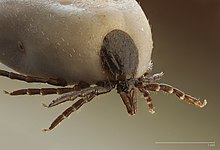Tick-borne encephalitis
This article needs additional citations for verification. (January 2010) |
| Tick-borne meningoencephalitis | |
|---|---|
Infectious disease |
Tick-borne encephalitis (TBE) is a
The number of reported cases has been increasing in most countries.[2] TBE is posing a concerning health challenge to Europe, as the number of reported human cases of TBE in all endemic regions of Europe have increased by almost 400% within the last three decades.[3]
The tick-borne encephalitis virus is known to infect a range of hosts including ruminants, birds, rodents, carnivores, horses, and humans. The disease can also be spread from animals to humans, with ruminants and dogs providing the principal source of infection for humans.[4]
Signs and symptoms

The disease is most often biphasic. After an incubation period of approximately one week (range: 4–28 days) from exposure (tick bite) non-specific symptoms occurs. These symptoms are fever, malaise, headache, nausea, vomiting and myalgias that persist for about 5 days.[1][3][5] Then, after approximately one week without symptoms, some of the infected develop neurological symptoms, i.e. meningitis, encephalitis or meningoencephalitis. Myelitis also occurs with or without encephalitis.[1][3][5][6]
Sequelae persist for a year or more in approximately one third of people who develop neurological disease. Most common long-term symptoms are headache, concentration difficulties, memory impairment and other symptoms of cognitive dysfunction.[1]
Mortality depends on the subtype of the virus. For the European subtype mortality rates are 0.5% to 2% for people who develop neurological disease.[3]
In dogs, the disease also manifests as a neurological disorder with signs varying from tremors to seizures and death.[4]
In ruminants, neurological disease is also present, and animals may refuse to eat, appear lethargic, and also develop respiratory signs.[4]
Cause
TBE is caused by tick-borne encephalitis virus, a member of the genus Flavivirus in the family Flaviviridae. It was first isolated in 1937. Three virus sub-types also exist:
- European or Western tick-borne encephalitis virus (transmitted by Ixodes ricinus)
- Siberian tick-borne encephalitis virus (transmitted by I. persulcatus)
- Far-Eastern tick-borne encephalitis virus, formerly known as Russian spring summer encephalitis virus (transmitted by I. persulcatus).[3][7]
The former Soviet Union conducted research on tick-borne diseases, including the TBE viruses.
Transmission

It is transmitted by the bite of several species of infected woodland ticks, including Ixodes scapularis, I. ricinus and I. persulcatus,[8] or (rarely) through the non-pasteurized milk of infected cows.[9]
Milk
Infection acquired through goat milk consumed as raw milk or fresh cheese (Frischkäse) has been documented in 2016 and 2017 in the German state of Baden-Württemberg. None of the infected had neurological disease.[10]
Diagnosis
Detection of specific IgM and IgG antibodies in patients' sera combined with typical clinical signs, is the principal method for diagnosis. In more complicated situations, e.g. after vaccination, testing for presence of antibodies in cerebrospinal fluid may be necessary.[3] It has been stated that lumbar puncture always should be performed when diagnosing TBE and that pleocytosis in cerebrospinal fluid should be added to the diagnostic criteria.[11]
PCR (polymerase chain reaction) method is rarely used, since TBE virus RNA is most often not present in patient sera or cerebrospinal fluid at the time of neurological symptoms.[11]
Prevention

Prevention includes non-specific (tick-bite prevention) and specific
Tick-borne encephalitis vaccines are very effective and available in many disease endemic areas and in travel clinics.[13] Trade names are Encepur N[14] and FSME-Immun CC.[15]
Treatment
There is no specific
Epidemiology
As of 2011, the disease was most common in Central and Eastern Europe, and Northern Asia. About ten to twelve thousand cases are documented a year but the rates vary widely from one region to another.[16] Most of the variation has been the result of variation in host population, particularly that of deer. In Austria, an extensive vaccination program since the 1970s reduced the incidence in 2013 by roughly 85%.[17]
In Germany, during the 2010s, there have been a minimum of 95 (2012) and a maximum of 584 cases (2018) of TBE (or FSME as it is known in German). More than half of the reported cases from 2019 had
In Sweden, most cases of TBE occur in a band running from Stockholm to the west, especially around lakes and the nearby region of the Baltic sea.
References
- ^ S2CID 901857.
- PMID 18761916.
- ^ a b c d e f "Factsheet about tick-borne encephalitis (TBE)". European Centre for Disease Prevention and Control. 18 June 2017. Retrieved 15 January 2019.
- ^ a b c Tickborne Encephalitis Virus reviewed and published by WikiVet, accessed 12 October 2011.
- ^ S2CID 59252822.
- PMID 18755391.
- ^ "Tick-borne Encephalitis (TBE)". Centers for Disease Control and Prevention. Retrieved 15 January 2019.
- PMID 10825054.
- ^ CDC Yellow Book, accessed 5 October 2013.
- ^ a b "FSME: Risikogebiete in Deutschland" (PDF). Epidemiologisches Bulletin, RKI (in German). 8. Berlin. 2020.
- ^ S2CID 12844392.
- PMID 25984517.
- PMID 19160184.
- ^ "Encepur® N". compendium.ch. 28 April 2016. Retrieved 21 January 2018.
- ^ "FSME-Immun® CC". compendium.ch. 11 August 2017. Retrieved 21 January 2018.
- PMID 21661276.
- ^ PMID 23377671.
- PMID 24618209.
- PMID 21968422.
- PMID 22085619. Retrieved 4 June 2016.
- ^ "Tickborne Encephalitis". CDC.gov. Retrieved 4 June 2016.
External links
- Tickborne encephalitis at Centers for Disease Control and Prevention (CDC)
- Factsheet from Viral Special Pathogens Branch at the CDC
